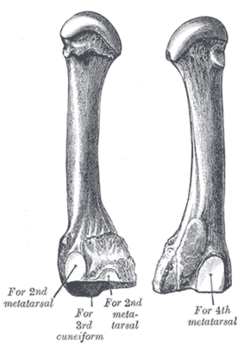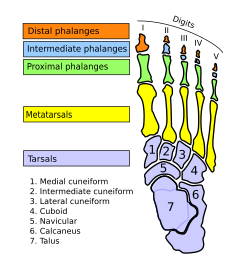| Third metatarsal bone | |
|---|---|
 The third metatarsal. (Left.) | |
 Bones of the right foot. Dorsal surface. Third metatarsal bone is the yellow bone third from the left | |
| Details | |
| Identifiers | |
| Latin | os metatarsale III |
| FMA | 24504 |
| Anatomical terms of bone | |
The third metatarsal bone is a long bone in the foot. It is the second longest metatarsal, the longest being the second metatarsal. The third metatarsal is analogous to the third metacarpal bone in the hand[1]
Like the four other metatarsal bones, it can be divided into three part: base, body and head. The base is the part closest to the ankle and the head is closest to the toes. The narrowed part in the middle is referred to as the body of the bone. The bone is somewhat flattened, giving it two surfaces: the plantar (towards the sole of the foot) and the dorsal side (the area facing upwards while standing).[1] These surfaces are rough for the attachment of ligaments. The bone is curved longitudinally, so as to be concave below, and slightly convex above.
The base or posterior extremity is wedge-shaped.[1] The third metatarsal bone articulates proximally, by means of a triangular smooth surface, with the third cuneiform; medially, by two facets, with the second metatarsal; and laterally, by a single facet, with the fourth metatarsal. This last facet is situated at the dorsal angle of the base.
The head or anterior extremity articulates with the third proximal phalanx.
YouTube Encyclopedic
-
1/3Views:142 6794 347582
-
Stress Fractures Of The Metatarsal Bones - Everything You Need To Know - Dr. Nabil Ebraheim
-
Anatomy and Osteology of the 3rd / Third Metatarsal
-
Third Metatarsal fracture repair- Podiatry Hotline Foot and Ankle
Transcription
Muscle attachments
 |
 |
The second and third dorsal interossei muscles attaches to the third metatarsal bone. The second dorsal interossei from the medial side of the bone and the third dorsal interossei from the lateral side. The function of the muscle is to spread the toes.[2]
The first Plantar interossei muscle originates from the medial side of the base and shaft of the third metatarsal. The function of the muscle is to move the third toe medially and move the toes together.[2]
The horizontal head of the adductor hallucis also originates from the lateral side of the metacarpophalangeal joint and from the deep transverse metatarsal ligament,[2] a narrow band which runs across and connects together the heads of all the metatarsal bones.
| Muscle | Direction | Attachment[3] |
|---|---|---|
| Dorsal interossei II | Origin | Medial side of the shaft |
| Dorsal interossei III | Origin | Lateral side of the shaft |
| Plantar interossei I | Origin | Medial side of the base and shaft |
| Horizontal head of adductor hallucis | Origin | Deep transverse metatarsal ligament and the metacarpophalangeal joint |
Additional images
-
X-ray of foot, showing phalangeal fracture
-
Skeleton of foot. Medial aspect.
-
Oblique section of left intertarsal and tarsometatarsal articulations, showing the synovial cavities.
-
Foot bones - tarsus, metatarsus
-
Foot bones - metatarsus and phalanges
-
Metatarsus
References
![]() This article incorporates text in the public domain from page 274 of the 20th edition of Gray's Anatomy (1918)
This article incorporates text in the public domain from page 274 of the 20th edition of Gray's Anatomy (1918)
- ^ a b c Bojsen-Møller, Finn; Simonsen, Erik B.; Tranum-Jensen, Jørgen (2001). Bevægeapparatets anatomi [Anatomy of the Locomotive Apparatus] (in Danish) (12th ed.). p. 246. ISBN 978-87-628-0307-7.
- ^ a b c Bojsen-Møller, Finn; Simonsen, Erik B.; Tranum-Jensen, Jørgen (2001). Bevægeapparatets anatomi [Anatomy of the Locomotive Apparatus] (in Danish) (12th ed.). pp. 300–301. ISBN 978-87-628-0307-7.
- ^ Bojsen-Møller, Finn; Simonsen, Erik B.; Tranum-Jensen, Jørgen (2001). Bevægeapparatets anatomi [Anatomy of the Locomotive Apparatus] (in Danish) (12th ed.). pp. 364–367. ISBN 978-87-628-0307-7.





